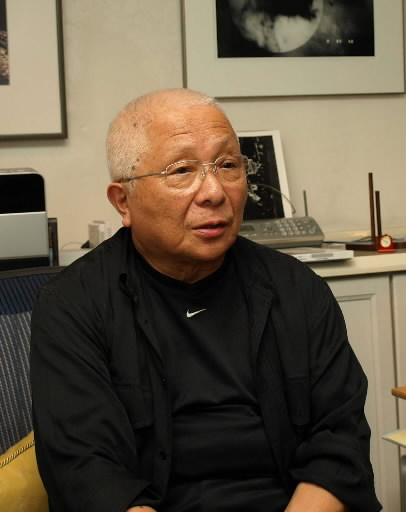Focusing on Hiroshima: The Lives of 5 Photographers, Part 5
Aug. 23, 2009
Kikuji Kawada: Stains of the A-bomb Dome underlie his work
by Kazunobu Ito, Staff Writer
When Kikuji Kawada, now 76, visited Hiroshima for the first time in 1957, he was a photographer for a weekly magazine. He was involved in covering the celebrated photographer Ken Domon as he took photos in Hiroshima. After work, in the evening, Mr. Kawada ventured into the A-bomb Dome alone, and the stains covering the dark and damp ceiling attracted his attention.
“The stains were clearly different from ordinary ones left from exposure to the elements,” he recalled. “It suddenly occurred to me that the marks had been burned into the ceiling at the moment the bomb exploded.” To Mr. Kawada, the marks were an image that symbolized the brutal violence and catastrophe of Hiroshima. “I somehow sensed right away that the stains were a monument I had to record,” he said.
His photos, taken more than 10 years after the atomic bombing, show the black stains on the dome’s ceiling twisting in all directions. “The images are dark and dismal, intricate and obsessive,” commented author Kenzaburo Oe. The photos stir the human imagination like an abstract painting.
Mr. Kawada’s interest in photography began in high school. After he graduated, a photo he submitted to a contest sponsored by a photography magazine won the highest prize. It was Ken Domon who selected his photo. “If that hadn’t happened, I might have led a very different life,” he said.
Mr. Kawada hoped to photograph Hiroshima but in a different way from the great photographer that had judged his photo. But finding a motif to embody the theme was not an easy task. “The moment I found those stains was an important turning point in my life,” he recalled.
After becoming a freelance photographer, he visited Hiroshima a number of times and pursued the “voiceless art of stains.” This effort determined his direction of focusing on psychological and symbolic images and empowering objects to tell stories.
In his first collection of photos, a book published in 1965 entitled The Map, the stains were the main theme, but he added photos of a kamikaze pilot, the ruins of a fort, iron scrap from small factories to connote post-war reconstruction, and a pack of Lucky Strike cigarettes brought in by a member of the occupation army. The collection is filled with images that are symbolic of World War II and Japanese cities in the post-war chaos.
“The Map is a map of my own frame of mind as well as a map of post-war Japanese mentality,” he explained, describing a collection which bears the unique design of printing images across facing pages and still stands out in the history of Japanese photography.
He has produced many works, energetically exploring a variety of themes, such as European gardens and castles, celestial bodies including a solar eclipse, and cities undergoing continual transformation. At first glance, these subjects do not seem related to one other, but underlying them all is the omnipresent theme of the stains on the A-bomb Dome.
Ever since the terrorist attacks in the United States on September 11, 2001, Mr. Kawada has felt uneasy each September 11 and roams Tokyo taking pictures. “Good photos can convey illusions or fantasies, not just what we can actually see,” he said. “Photographing the stains gave me the competence to capture that kind of image.” In addition, his works are also imbued with an acute sense of the time in which they were produced.
Last summer, seven photos from The Map were displayed in an exhibition on the theme of the A-Bomb Dome at the Hiroshima City Museum of Contemporary Art. “My style is constantly evolving, and it feels a bit awkward that only the photos of stains attract people’s attention,” Mr. Kawada said. “Still, it’s great if the form or image of a work can continue to stir people’s imaginations as times change.”
More than 40 years have passed since his last visit to Hiroshima, and he has no plan to return to the city in the near future. Yet we await with interest to see what this evolving artist will train his camera on next.
Kikuji Kawada
Born in Ibaraki Prefecture and now residing in Shinjuku, Tokyo. After graduating from Rikkyo University, he became a photographer for the Shinchosha Publishing Company and worked on the weekly Shukan Shincho magazine from its first issue. He became a freelance photographer in 1959 and is one of the founders of the photographers’ group “VIVO.” Mr. Kawada was awarded the Domestic Photographer Prize of the Higashikawa Prize in 1996 and the Minister of Education, Culture, Sports, Science and Technology’s Art Encouragement Prize. His works include Sacre Atavism and The Globe Theatre.
(Originally published on August 1, 2009)








